Thomas Morris of King Street
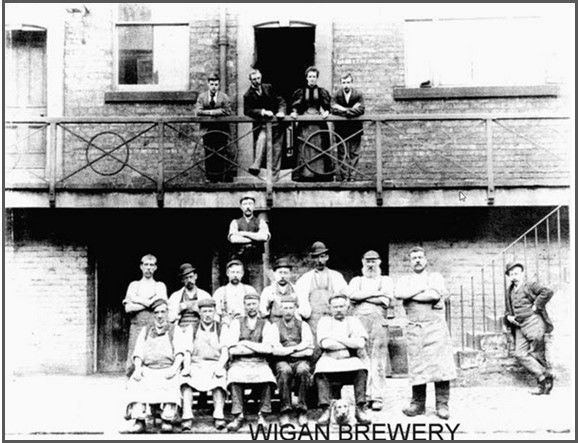
Introduction
As part of the wider King Street Heritage Zone project, 'The Street That Was', this article focuses primarily on Wigan businessman Thomas Morris, his daughter Ellen Ann Robinson Morris, and their connection to the Wigan Brewery in King Street during the 19th century.
Influential Local Family
Thomas was from a long established and influential local family. He was born in Scholes on 22 January 1794, the fifth son of Robert Morris (1750-1812) and Hannah Tyrer (1756-1832). He was baptised on 16th March at All Saints Parish Church, Wigan.
His father Robert, who hailed from Shevington, was an attorney, but by 1785 he was listed as a ‘Chapman’, a merchant or dealer who invested in the raw cotton trade, in Robert’s case ‘fustian’. This was a hard wearing twilled cloth with a short nap, favoured by the manual workers of the time.
By 1789 Robert had moved from Wallgate to Scholes where he opened a cotton factory. He also became a councillor and in the last years of the 18th century he was elected Mayor of Wigan three times, in 1791,1796, and 1799.
By 1804 the British cotton industry was booming and cotton goods accounted for 42% of the country’s exports. That year Robert built a new factory in Scholes, six stories high, on the corner of Scholes and Platt Lane. To finance his enterprise he advertised his old factory, also in Scholes, for sale by auction, along with his house and four cottages.
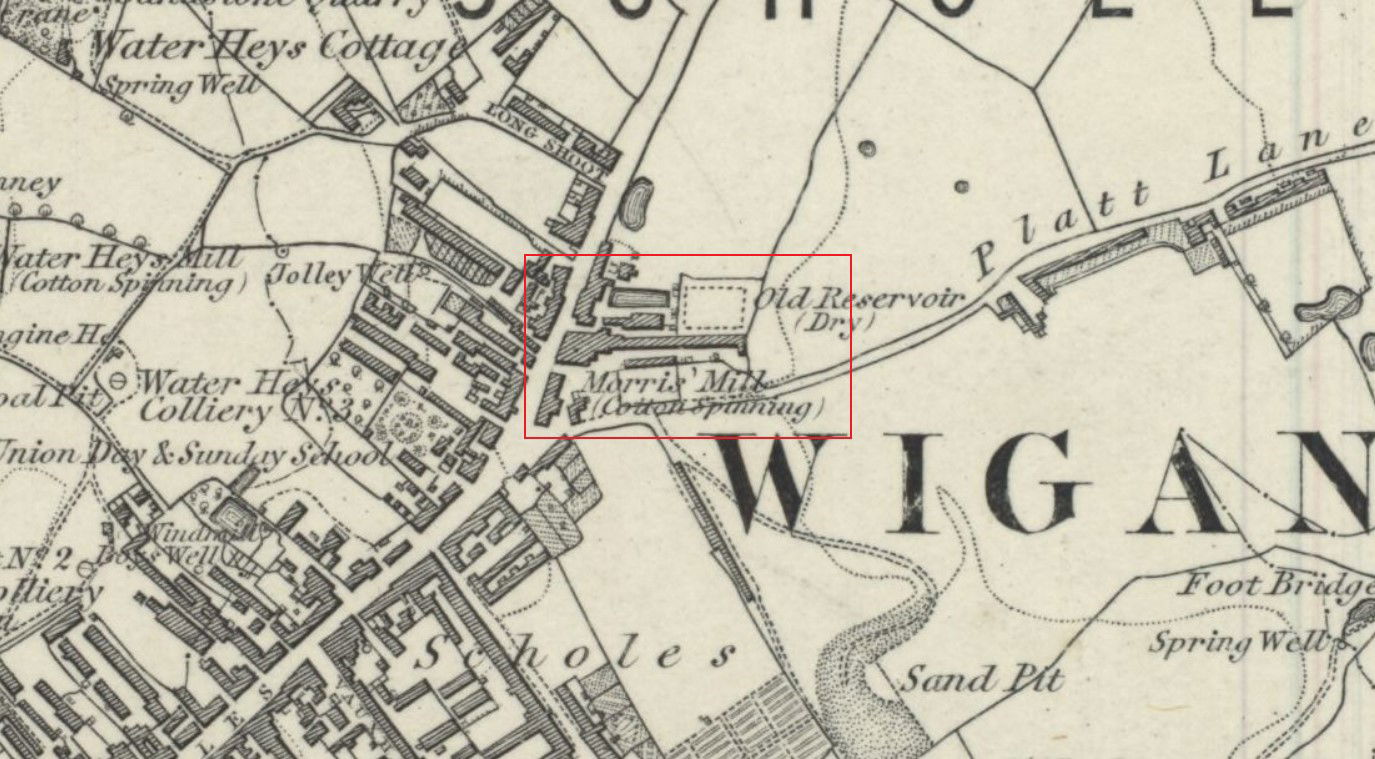
Location of the Morris Mill located at the junction of Scholes and Platt Lane, on the Ordnance Survey map published in 1849
He also sold three cottages in Haigh jointly owned with his brothers, John of Liverpool, and Thomas of Bolton le Moors. As well he sold a field of one and half acres of land, known as ‘Tenter Hay’, which was off nearby Platt Lane, and relinquished five and half acres of land in Haigh leased from the Earl of Balcarres.
The following year however, Robert experienced financial difficulties and had to declare himself bankrupt. This was confirmed by a notice in the London Gazette on 2 February 1805. On 24 April of that year an auction was held at 4pm in the Eagle and Child Inn in Standishgate. Advertised for sale was his new factory, steam engine and all associated machinery, along with sixteen adjoining cottages. Also mines, quarries, and delves of coal, cannel, and stone within 14 acres of land. His factory was purchased by Henry Bullock and John Swan, local cotton manufacturers.
Robert died in 1812 aged 61 and was buried in the family vault in All Saints parish church in Wigan on the 10th of April of that year.
Business Empire
Robert and Hannah had seven children, five boys and two girls. Thomas, the youngest son became a solicitor with offices in Wallgate, his home being in Percival Place, off Hallgate. He married Ann Robinson (known to family as Nancy) on 22 January 1829 at All Saints Parish Church.
Ann was born in Lathom, near Ormskirk, the daughter of Henry Robinson, and Ellen Harrison who was born in Ormskirk. As no local baptism records are evident, other sources suggest that Henry had been born in York.
He was at one time the licensee of the Brewer‘s Arms public house, adjacent to the Wigan Brewery at the corner of King Street and Chapel Lane.
The founding of Wigan brewery and malting business is credited to Thomas Higson during the 1780's. On 1 June 1790 he went into partnership with William Chapman, and James and George Bevan. At some point George Bainbridge joined the partnership.
A notice in the London Gazette dated 8 May 1798 stated that as from 17 April 1798 the partnership between Thomas Higson, William Chapman, James Bevan, George Bevan and George Bainbridge, trading as Thomas Higson & Co. Brewers of Wigan, was dissolved. The business carrying on as George Bainbridge & Co.
On 1 January 1802 George Bainbridge & Co. was dissolved, with William Chapman, James, and George Bevan continuing. The records of 'Articles of Co-Partnership' held by Taylor, Bridge, Baron, and Sykes, solicitors of Wigan dated 1 December 1803 show that Henry went into partnership with James and George Bevan, William Chapman and Thomas Dean of Lancaster to acquire Wigan brewery for a seven year term. The business was now to be known as Henry Robinson & Co.
William Chapman and James Bevan then left, to be replaced by Margaret Bevan. Thomas Dean dissolved the partnership in 1816, followed by James and Margaret Bevan in 1821.
Henry then went into partnership with John Hodson Kearsley, a prominent Wigan businessman, the commander of the Wigan Rifle Volunteers, a former three times Mayor of the Borough, and Member of Parliament. The brewery continued to trade under the name of Henry Robinson & Co.
In the details of the joint partnership agreement, it was agreed that on the death of one of the partners the personal representatives of the deceased would agree to sell their moiety/share of the company to the surviving partner.
Henry became a victim of violence during the election riots of 1831 in Wigan, when businesses were ransacked and prominent businessmen attacked. He was singled out for physical assault on 4 May because of his strong links to John Hodson Kearsley and the Wigan Brewery.
Henry Robinson died of a stroke in August 1833. He died intestate, his son and heir George had been declared a lunatic the previous year so his son in law Thomas Morris and his daughter Ann were appointed joint committee of his estate.
They agreed to sell Henry’s share and the arrangement was completed, comprising of a substantial portfolio of 345 properties, varying from copyhold, freehold and leasehold. In 1837, the legitimacy of the sale was unsuccessfully contested by the Morris family.
Thomas Morris put his profession as a lawyer to one side and continued to be involved in the successful running of John Hodson Kearsley's wholly owned company. He also was to become a successful entrepreneur. An early venture was entering into partnership with Henry, his father in law, and Thomas Ashall, who owned mines in Ince and Wigan, but on 11 Dec 1832 the partnership was dissolved, owing to debts incurred by Ashall.
In 1835 Thomas purchased Brunswick Villa, an eight bedroom property in two acres of land at the junction of Lord Street and Manchester Road in Southport (the building has been demolished and at the time of writing a Farmfoods store occupies the site). Thomas is shown residing at Brunswick Villa along with his wife and daughter on the 1841 census. Brunswick Villa became Ann and Ellen’s permanent residence as confirmed by the next three census’s and Ann’s death there in 1869.
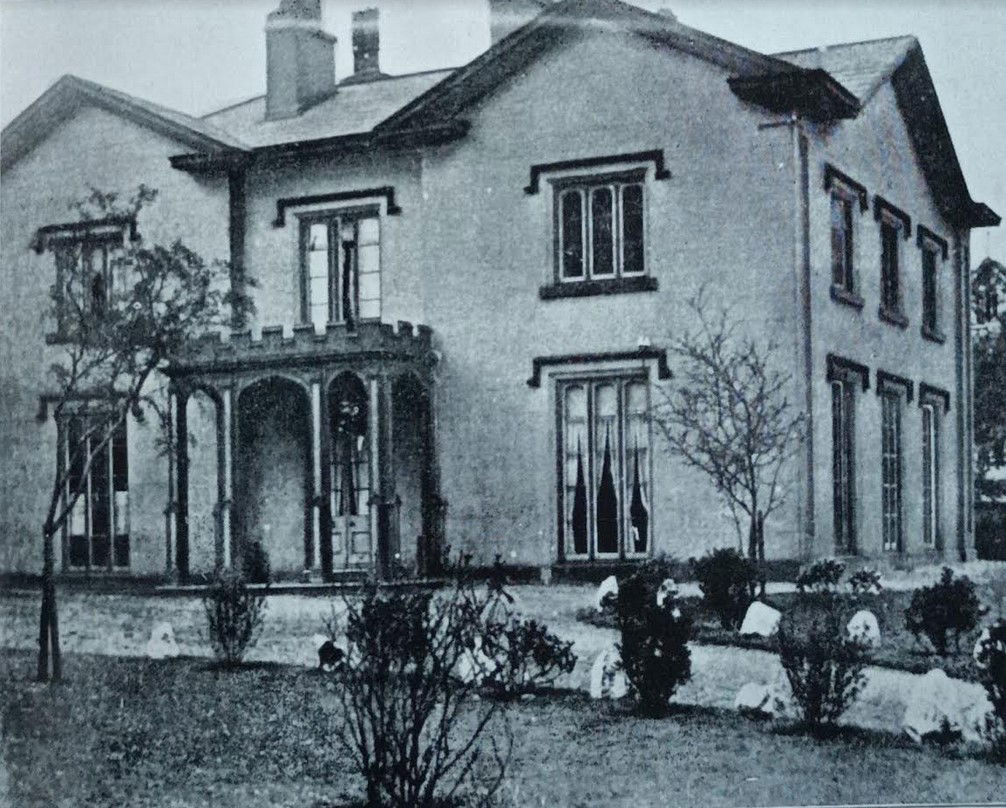
Brunswick Villa, Southport
In 1842 John Hodson Kearsley died and the brewery which was capable of producing 300 to 400 barrels of beer a day was put up for sale by auction, over three days from 3rd to 5th of July 1843 at the Royal Hotel in Standishgate, Wigan. As well as the brewery the sale included 43 inns and public houses and numerous cottages, as well as 70 shares in the Wigan Gas Light Company.
Thomas successfully became the sole owner, still trading under the name of Henry Robinson & Co. Not knowing the practicalities of the brewery trade he employed managers to run the brewery. One of which was Thomas Rogers of Whiston, he had at one time been butler to Lord Crawford, then landlord of the Ship Inn, before being appointed brewery manager. Instead Thomas Morris focused on the potential business opportunities provided by the expansion of the railway system, which was a crucial component of the industrial revolution.
There were three separate periods of intensive and speculative railway promotion, investment and construction: known as the ‘railway manias’. During the second ‘mania’ in the mid 1840’s, 330 Railway Acts were passed to establish new railway companies or extend existing railway lines.
The raising of nearly 170 million pounds of capital (equivalent to nearly 26 billion pounds today) was authorized for the construction of these railways in England and Wales and it has been estimated that, at the height of the mid -1840s mania, individual capitalists invested more than twice as much into the construction of railways as the state spent on the military.
In the period between 13 September to 1 November 1845 Thomas invested heavily in the railways and became a director of seven new start up railway companies. These included the Liverpool, Preston & North Union Junction Railway (with branches to Southport and Wigan). The West End & Croydon Railway. The Staffordshire, Potteries, and Liverpool & Manchester Direct Railway. The Leeds & Liverpool Direct Railway, (via Wigan, Bolton, Bury, Rochdale and Halifax, commencing at the Bury terminus of the Liverpool and Bury Railway). The Manchester, Southport & Wigan Railways. The Blackburn, Chorley & North Union Junction Railway, and the North Union, Trent Valley & Midland Counties Junction Railway.
He also invested in several more and became a shareholder in the Keighley, Halifax & Huddersfield Junction Railway (via Elland, Leeds, to intersect the Liverpool Leeds Direct Railway at Halifax). The Liverpool & Bolton Direct Railway (with extension to Garston), and the Central Kent Railway.
Like most prominent businessmen in the town Thomas entered into local politics and in August 1846, following the sudden death of Councillor Samuel Holt, was elected without opposition to be councillor for the All Saints Ward. That year he was also appointed as the chief magistrate of Wigan Borough.
Following in his father’s footsteps he was elected Mayor of Wigan on 9 November 1846. The following year he was nominated by the Wigan Conservative Party to stand as the next Parliamentary candidate should the incumbent MP Charles Strickland Standish not be able to defend his seat. In April 1848 Thomas was elected to be a Member of the Wigan Board of Guardians.
Thomas owned a lucrative Toll Bar in King Street, near Victoria Buildings, which controlled all the traffic to businesses in the street. In December 1848 the Wigan Observer & District Advertiser ran an article under the headline, ‘Liberal Gift to the People of Wigan’. It stated that ‘Mr. Thomas Morris, the proprietor of the Toll-Bar in King St, Wigan, has come to the determination on or after the first of January 1849 to take down the bar, give up his right to Toll and throw open the street to the public of Wigan’.
On 2 June 1849 he was invited to lay the foundation stone at Christ Church in Newburgh, the funds, and the site on which to build the church were donated by the Earl of Derby.
Sometime in the mid 1850’s Thomas purchased Fairhurst Hall in Chorley Road, Parbold, part of the vast Standish Estate. The hall was a mid-18th century building with 14th century remains. (It was extensively altered in the mid 20th century and Grade 2 Listed in 1988).

Fairhurst Hall, Parbold
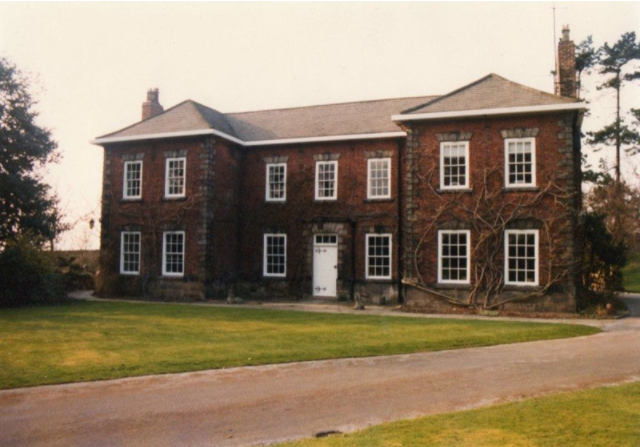
Fairhurst Hall, Parbold, after the 20th century alterations
The Estate was set in 18 acres of productive arable and pasture land with plantations, fish pond and produce and ornamental gardens. The house was comprised of drawing, dining, breakfast and billiard rooms, kitchens, pantries, larders, and laundry, as well as a game closet and gun room. Upstairs were eight bedrooms with associated dressing rooms and water closets. The outbuildings comprised of a coach house, stables for six horses, a large barn, hen houses, and a dairy.
In 1862 Thomas purchased La Mancha Hall, on the large Renacres Estate in Renacres Lane, Halsall. The seven bedroom mansion was set in 10 acres of extensive grounds with formal gardens, woodlands, ponds, stables and paddocks. It came with an associated farm known as the Vineries Lodge. It was built in the mid 1700's, said to be by an unknown Spaniard as ‘La Mancha’ is a region in central Spain. (the building was Grade 2 listed in 1968).

La Mancha Hall, Halsall
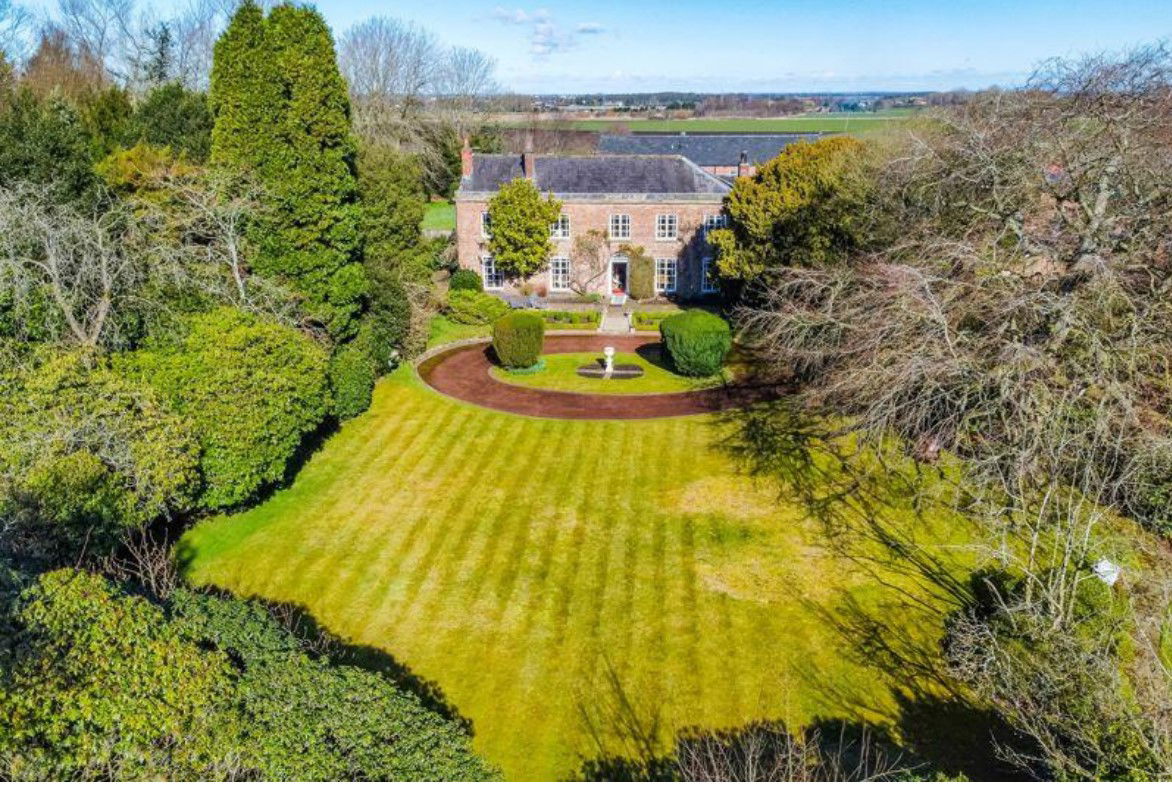
Aerial view of La Mancha Hall, Halsall
In 1863 the Wigan Brewery was modernized, Thomas advertised tenders from building firms to carry out the alterations and extensions, before employing Chester architect James Harrison to carry out the rebuilding work.
Thomas’s wife Ann died 21 March 1869 at Brunswick Villa in Southport, probate records show that her estate of £10,191 (worth 1.5 million pounds today) was left to her daughter Ellen.
Thomas who had been in ill health for many years, died 20 May 1871, aged 77, at Fairhurst Hall. He was buried four days later in the graveyard at All Saints Parish Church in Wigan. On the day of the funeral a special train left Wigan Wallgate station at 9am, taking a number of his friends to Newburgh railway station.
His body, encased in a metal container inside an oak coffin was carried from Fairhurst Hall to the station and brought back to Wigan, arriving at 12 noon. From there employees of Thomas bore his body to Wigan Parish Church where he was interned in the family vault by Revd. William Price of Christ Church, Parbold and the Rector of Wigan Parish, the Hon George Thomas Orlando Bridgeman.
Ellen Ann Robinson Morris (1830-1915)
Thomas and Ann’s daughter, Ellen Ann Robinson Morris was born 7 January 1830 in Percival Place and baptised at Wigan Parish Church on the 30th of July.
In 1870, in memory of her mother, Ellen funded the building of a new church on the slopes of Parbold Hill, which was to be known as Christ Church, Douglas in Parbold.
It was to replace the 14th century Douglas Chapel located in Chapel Street at the foot of Parbold Hill near the Leeds & Liverpool Canal. It was also called the ancient chapel of St. Mary, as it's mother church was St. Mary the Virgin in Eccleston. Her mother had been baptised at the old chapel and worshipped there before her marriage to Henry Robinson.
The sandstone for the construction came from a quarry in Parbold but also some stone was transported from Longridge, near Preston. Some parts of the old Douglas Chapel were used in the new church, including the pulpit which dated from 1648, and an early 1700’s font. (In 1988 Historic England designated Christ Church as a Grade 2 listed building of being historical and architectural importance).
On 26th September 1870, a ceremony was held to celebrate the laying of the foundation stone by Ellen. Speeches were made, hymns were sung and a presentation was made to Miss Morris of an engraved silver trowel from the churchwardens of the old Douglas Chapel and the people of the local community. The Wigan Observer & District Advertiser reported on the event and stated that the cost of the church would be over £5000. (worth £750,000 today)
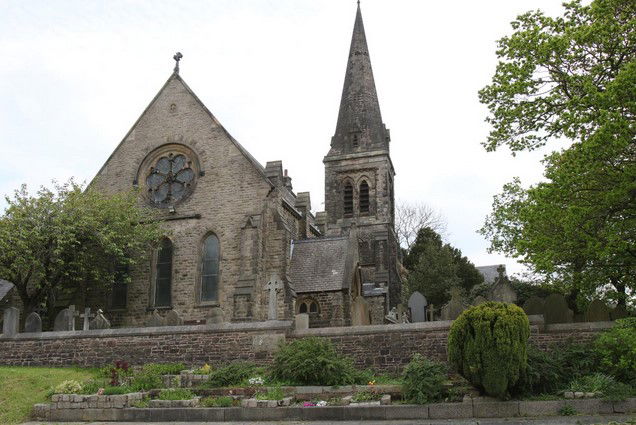
Christ Church, Douglas in Parbold
Lunacy and Legal Challenges
After the death of her father in 1871, Ellen, a forty one year old spinster with no siblings or close family to offer support, found herself heiress to her father’s wealth and in charge of Henry Robinson & Co. The brewery alone was worth approximately 12,000 to 15,000 pounds per annum (approx 1.75 million to 2.1 million pounds today).
Events were soon to conspire against her. The following year a court case arose and Ellen was the subject of a lunacy order, instigated by members of her own family. She was declared a lunatic by the Lunatic Commission in November 1872, and her estate would now be ‘Administered in Lunacy’ by appointed trustees.
In the 19th century the definition of lunacy differed greatly to that of today. The Victorians had little understanding of mental illness. Anyone suffering from depression, acute anxiety, melancholy, dementia or post-natal depression could be branded of being of unsound mind and therefore a lunatic, and statistically many more women than men suffered lunacy orders.
Normally a doctors certificate and an order from a Justice of the Peace or clergyman was enough for a poor person to be incarcerated in a workhouse or lunatic asylum. In the case of private wealthy patients it required a medical certificate signed by two physicians. Private ‘Care Homes’ were available, but if the lunatic’s family was wealthy enough then special arrangements could be made for live in nurses to care for the patient. This seems to have happened in Ellen’s case.
In June 1875, just a couple of months before Christ Church at Parbold was consecrated, Ellen’s legal guardians and representatives had to defend her in the probate court. A legal challenge had been made by Ellen's relatives, which disputed Thomas Morris’s last will and testament, dated 28 July 1859, and two new codicils dated 2 March 1869 and 21 February 1870 respectively. The case was presided over by Judge Sir James Hannen and the outcome would be decided by a special jury.
It was stated by various paternal family members that Thomas was not of sound mind when he signed the second of two codicils. They accused Ellen of illegally influencing her father by telling him he was signing a paper for a new codicil rewarding old servants with legacies, when in fact he was changing his will which greatly affected potential beneficiaries.
In his will, after leaving a few legacies Thomas left the residue of his estate to his wife Ann for the remainder of her life, and at her death, to his daughter until she married, but without powers of appointment. If Ellen did not marry and produce heirs then the whole of the property would be divided amongst the next of kin, who were the defendants in the litigation.
The first codicil to the will was dated 25 April 1867. In it he appointed Mr. Jonathon Lamb of Wigan an additional executor and trustee with power to Mr Lamb and Mr Eckersley to carry on his business as a brewer and wines and spirits merchant, each to receive out of the estate £400 a year for his trouble. (worth £55,000 today)
The second codicil of 1869, revoked the appointment of Mr. Eckersley and substituted him for Mr. John Grant Morris, a local mine owner of Wigan.
In the third codicil he expressed the desire that his daughter should have the entire control of all his affairs without the interference of any person, and declared her to be the sole executrix and trustee of his will.
Counsel for the next of kin drew attention to the fact that his daughter Ellen was a lunatic. Also that her brother George Robinson had been declared a lunatic in 1832, five years before his premature death in December 1837, aged 44, from drowning in the Leeds & Liverpool Canal at Lathom. It was also noted that Thomas, his wife Ann, and his daughter Ellen had a peculiar relationship, frequently living apart, each occupying alone one of their three residencies.
Several witnesses were brought forward and testified that Thomas was of unsound mind in the last few years of his life, and incapable of looking after himself. Dr. Marsden of Ormskirk said his mind had gone and he was unable to hold a proper conversation, he considered him an imbecile.
Dr. Minshull of Abercrombie Square in Liverpool said he had known the deceased for twenty years, but lately had noticed a change as it was difficult to hold a conversation with him. He considered that in 1869 he was not capable of transacting business, after that he got worse, suffering from ‘softening of the brain’.
However, Thomas Morris was, on the whole, spoken of very highly by friends, business acquaintances and servants. They implied that he was just eccentric. Mr. Walter Mayhew, solicitor for Thomas Morris for many years, said he believed that his client knew exactly what he was doing when reading and signing the codicils. Walter Mayhew also attended to the affairs of his daughter Ellen, which would benefit him greatly in the future. Other witnesses gave evidence that he was unable to dress himself, childish in his manners and had a loss of memory.
During the court case, reference was made to Thomas Morris’s time spent at La Mancha with his wife and daughter. He would also entertain friends including James Burrows, the mayor of Wigan who would be invited to go shooting at La Mancha.
In addition, James Carr who had been the gamekeeper at La Mancha for the past 17 years spoke in favour of his employer. He had seen Thomas sign the paperwork and denied that he had been told it was just legacies for old servants who had left his employ. He had also supported Thomas at the funeral of his wife, Ann in 1869. After five days in court hearing evidence, and despite strong evidence by the defendants the jury came back with a decision in favour of Ellen. This in effect cut off the next of kin from the will, unless Ellen chose to benefit them.
Leaving Lancashire
In 1876 Ellen sold La Mancha and then Brunswick Villa, whose contents had been sold previously at auction. Fairhurst Hall was sold in 1878 by auction at the hall at 4.30pm on the 26 July. James Carr the long-time gamekeeper at La Mancha for the Morris family, is shown as a farmer and resident at Fairhurst Hall with his wife and family three years later on the 1881 census.
By 1891 James Ainscough, a member of the well-known local Catholic family was living at Fairhurst Hall. He added a new wing to the house, but this was later removed by a later resident, Dr. Tom Rigg in 1948.
Just like the Nelson family who had lived at Fairhurst Hall for many generations, the Ainscough's were one of the original recusant families who had settled in Lancashire from Lincolnshire and had links to Fairhurst Hall.
In 1804 the incumbent vicar of Douglas Chapel in Parbold reported to the Bishop of Chester that there were 67 Papist (Catholics) living in the Douglas Chapelry and they worshiped in three Catholic chapels in the area, Parbold Hall, Wrightington Hall, and Fairhurst Hall who each had their own dedicated priest. The Ainscough family worshipped at Fairhurst Hall and members of the family were married in the chapel there by a Priest, by the name of Orton.
James Ainscough’s father Hugh had purchased Lancaster House in Parbold in 1852 and greatly extended it. He leased it to the Sisters of Notre Dame of Liverpool in 1929, who then bought the freehold in 1947.
Hugh Ainscough and his brother Richard funded the building of a new church adjacent to Lancaster House. The foundation stone was laid in 1878 and the new church, known as Our Lady & All Saints was consecrated on 28 May 1884 by the Bishop of Leeds, Dr. Robert Cornthwaite.
Ellen Ann Robinson Morris left Lancashire and purchased Portobello House in Norwood, Surrey, quite close to Crystal Palace. It remained her main residence for the remainder of her life.
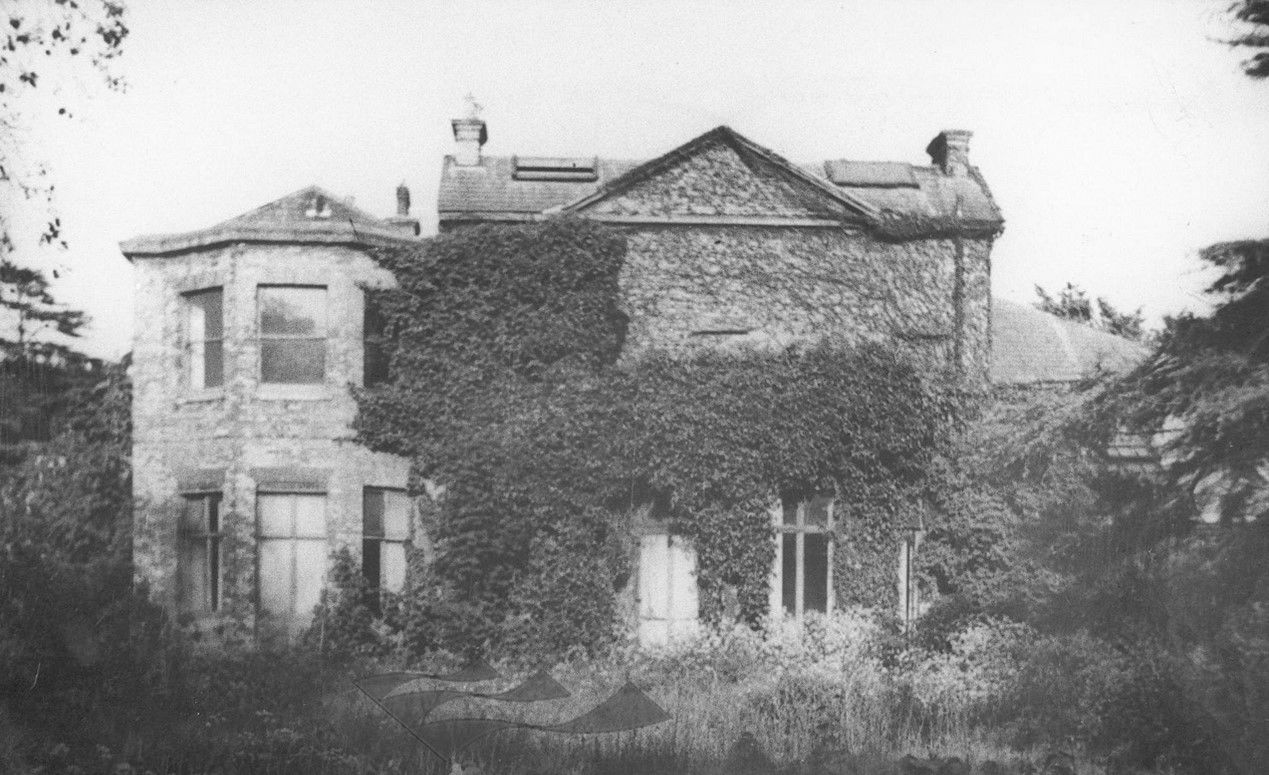
Portobello House, Norwood, Surrey
She was cared for by her companion, Eliza Cross and later by Harriet Jane Bainbridge, plus various faithful servants throughout the years. On the 1881 and 1891 census records, she was still classified as being a lunatic.
Ellen also spent time at another of her properties, ‘Hendersyde’ which was an impressive villa in Cary Road, overlooking Tor Bay in Torquay, a popular retreat for wealthy Victorian families. (Hendersyde has since been converted to private apartments, now known as the Bay).

Hendersyde, Torquay, now Bay Apartments
Despite Ellen being deemed unfit to be in charge, the Wigan Brewery continued to prosper under the control of the Trustees and the brewery managers. Eventually though, in September 1894 it was put up for auction with its 86 public houses, and an extensive wine and spirit store at 5 Rodney Street, Wigan.
Healey's Auctioneers held the auction at the Public Hall, King Street, Wigan on 28th September 1894. The bidding was chiefly between a Wigan syndicate and Mssrs Magee, Marshall & Co. Ltd of Bolton who were the successful bidders. They purchased the company for £175,000 (worth 28.5 million pounds today). The company was itself taken over by the large regional brewers Greenall & Co. Ltd in 1959 before closing in 1970.

The sale of Wigan Brewery 1894
The 1911 census finds Ellen at Hendersyde Villa in Torquay, with her companion Harriet Bainbridge and an entire household of staff including two mental health nurses, a butler, two cooks, housemaid, kitchen maid, and a footman. Her coachman William Neve and his wife Kate lived permanently at Hendersyde as house keepers.
That year Ellen’s representatives appealed against her lunacy order in the High Court but the case was rejected and the order still stood.
Ellen died four years later on 24th January 1915 at Portobello House in London, aged 85. As befitting a person of such stature, she was buried five days later in a prominent position close to the church walls just to the right of the entrance at Christ Church, Parbold, the church that she had funded and built. A note was written in the burial records stating the fact she had built the church at Parbold in memory of her mother.
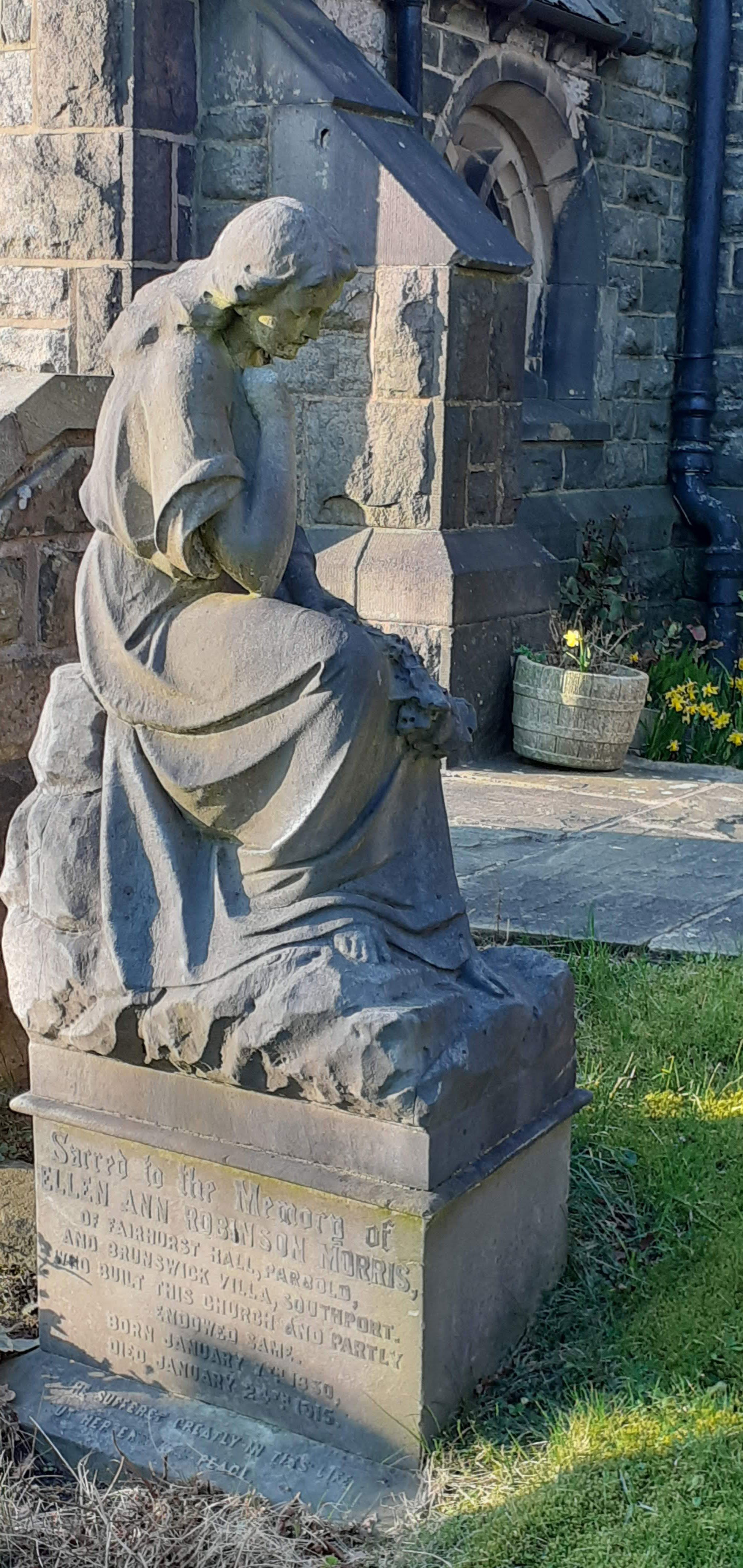
Gravestone of Ellen Ann Robinson Morris, Christ Church, Parbold
Another Legal Challenge
Probate of Ellen’s will was granted in London on 29th April 1915 to Ellen’s executor, Alderman Walter ‘Morris’ Mayhew, J.P of Duxbury Park, Chorley, senior partner in the firm Mayhew & Musgrave Peck of Wigan. He was the solicitor, and one time Mayor of Wigan who had worked for her and her parents for many years. However, the inclusion of ‘Morris’ as a middle name is a mystery as he was not baptised or known as such.
Ellen’s assets totalled £545,727, (69 million pounds today). Her primary bequeath was the donation of £3,000 for the erection of a new church on a suitable site in Newburgh plus £1,000 to pay the income of the duly appointed parson or minister of that church for ever. In the event of Revd William Price (the incumbent vicar of Christ Church, Parbold) being appointed the minister she also left to him an annuity of £50 whilst he acted as such minister. This was in addition to a one off payment of £1,000 to him.
She bequeathed £15,000, (2 million pounds today) to various organisations and businesses in Southport, including several schools, the Society for the Propagation of the Gospel, the Society for Prevention of Cruelty to Animals and the National Lifeboat Institution.
Various amounts of up to £2,000 were made to numerous individuals including her servants, two vicars, two doctors, a veterinary surgeon and a shopkeeper. £15 was left to the widow of James Hesketh who lost his life after being kicked by a horse whilst in her employ at La Mancha House in 1870. James had been sent to Ormskirk on an errand and stabled the horse at the Snigs Foot Inn in Church Street. On his return the horse kicked him in the stomach. After a short period of recovery he rode the horse home but three quarters of a mile from La Mancha he collapsed. He was attended to by a surgeon from Ormskirk but died the following day.
A Question of Legitimacy
After payment of estate and legacy duties, bequests and expenses, the residuary of Ellen’s property and assets of £430,000 (54.5 million pounds today) were held in trust by appointed trustees. Apart from her legacies and bequests in her will, Ellen died intestate.
By not naming any next of kin amongst her beneficiaries she was ensuring that a costly and lengthy legal battle would be the outcome. Her relatives, who had had her committed as a lunatic and challenged her father’s Last Will & Testament, would have to fight it out in court for three years after her death in order to claim their share of the fortune.
Justice Astbury of the Estate Chancery Division of the High Court of Justice presided over the case. In 1916 a notice appeared in all the main newspapers looking for any descendants of Christopher Morris, last heard of in Wigan in 1777. Also that of Alexander Morris, believed to have died in Barbados about 1815.
On 16 February 1917 Justice Astbury let it be known that in the case of Mayhew v Halton 1915 M. No. 613, all next of kin claimants had by noon on the 27 March 1917 to enter their names in a book in Room No. 287 at the Royal Courts of Justice in the Strand, London.
There were twenty eight claimants on the paternal side (Morris), represented by Mr. J.B Mathew KC, and nine claimants on the maternal side (Robinson) represented by Mr. Cunliffe KC. There was much at stake as the maternal next-of-kin had already raised £210,000 by mortgaging their expectant shares (worth 17.7 million pounds today).
A vast amount of evidence, including papers from the Derby Estate and other records was laid before the court and over a dozen counsel represented their parties.
The paternal side’s case centred on the legitimacy of Ellen’s mother Ann Robinson. If it could be proved that Ann was illegitimate, then the estate would pass down Ellen’s father’s side of the family, otherwise the members of her mother’s side would be the beneficiaries.
They claimed that Ann had been born before her parents’ marriage on 12 January 1791, and that a conspiracy of silence then ensued. Their evidence of illegitimacy was a statement in a lease signed on the 15th of December 1790 by the 12th Earl of Derby. The Lessee was Ann’s grandfather William Robinson of Ormskirk. The lease was for the duration of three lives, the second life was Henry, and the third life being that of Ann which the lease stated was six month old at the time.
What wasn’t in doubt was that Ann was born on 21 March, but if Ann was six months old when the lease was signed then she must have been born in 1790, some ten months before her parents wedding. If she had been born in 1791, then it was two months after her parents’ marriage.
Mr. Micklem KC, appearing for one of the insurance companies who had mortgaged shares of some of the maternal next of kin pointed out that the handwriting on the lease for the first two lives was different to that that of the third that gave Ann’s age. This suggested that her name and age was written in the lease at a later date, making the first date a false date.
The counsel for the maternal next of kin made it known to the judge that on her tombstone in the Wigan parish church yard she was described as the lawful daughter of Henry and Ellen Robinson. Furthermore that the inscription stated that her death occurred on her birthday, 21 March 1869, and that her age was 78, which made the year of her birth 1791.
Ruling that the lease was unreliable because the handwriting of the second and third lives was different, Judge Astbury upheld the legitimacy of Ann and came down in favour of the maternal next of kin claimants. This ensured that the estate would be distributed among the Robinson family. An agreement was made between the two parties that the paternal next of kin would not have to pay any costs if they agreed an undertaking not to appeal the judge’s decision.
This was to be the final chapter in the long running saga of the Wigan Brewery, and the legal challenges over the wealth that it had created over the previous one hundred years.
Graham Taylor 2024
Sources
Ancestry co.uk
Find My Past newspaper archives
Halsall Family Histories
istonline,org
History of Our Lady & All Saints Parbold
National Archives
Wigan Local History & Heritage Society
Wigan World
Wikipedia